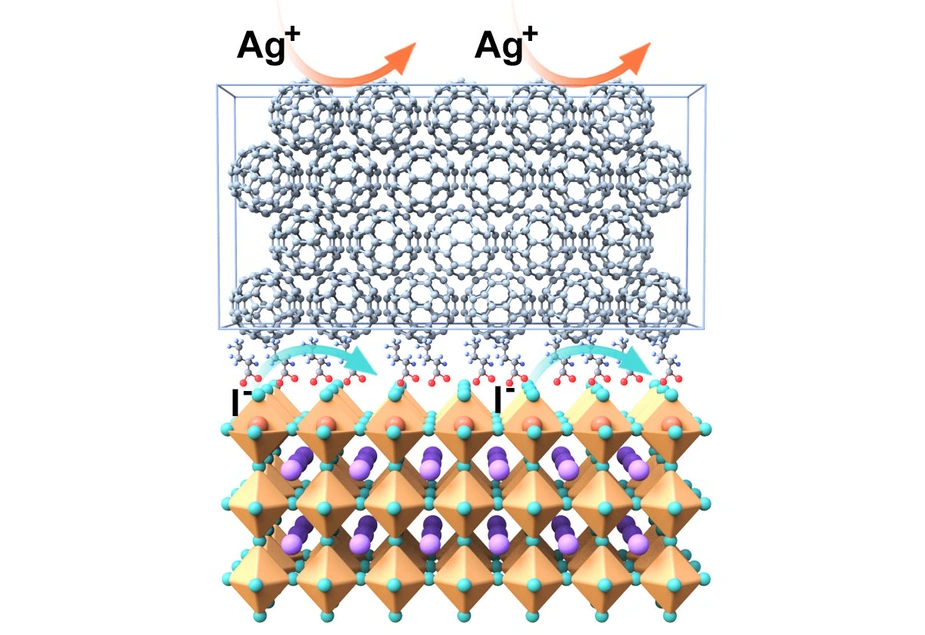Long-term stability for perovskite solar cells: a big step forward
A Teflon-like layer ensures exceptional stability and consistent efficiency
Perovskite solar cells are inexpensive to produce and generate a high amount of electric power per surface area. However, they are not yet stable enough, losing efficiency more rapidly than the silicon market standard. Now, an international team led by Prof. Dr. Antonio Abate has dramatically increased their stability by applying a novel coating to the interface between the surface of the perovskite and the top contact layer. This has even boosted efficiency to almost 27%, which represents the state-of-the-art. After 1,200 hours of continuous operation under standard illumination, no decrease in efficiency was observed. The study involved research teams from China, Italy, Switzerland and Germany and has been published in Nature Photonics.
‘We used a fluorinated compound that can slide between the perovskite and the buckyball (C60) contact layer, forming an almost compact monomolecular film,’ explains Abate. These Teflon-like molecular layer chemically isolate the perovskite layer from the contact layer, resulting in fewer defects and losses. Additionally, the intermediate layer increases the structural stability of both adjacent layers, particularly the C60 layer, making it more uniform and compact. ‘It's actually like the Teflon effect,’ says Abate. ‘The intermediate layer forms a chemical barrier that prevents defects while still allowing the electric contact.’
Much of the experimental research was conducted by the first author, Guixiang Li, while he was a PhD student in Abate's team. Guixiang Li is now a professor at Southeast University in Nanjing, China, and continues the collaboration. The study also involved teams from the École Polytechnique Fédérale de Lausanne (EPFL) and Imperial College London.
High efficiency plus stability
Using this approach, perovskite solar cells can achieve a lab-scale efficiency of 27 per cent, which is slightly higher than the 26 per cent efficiency without the intermediate layer. The increase in stability is huge: even after 1,200 hours of continuous illumination by a ‘standard sun’, this high efficiency does not decrease. ‘1,200 hours correspond to one year of outdoor use,’ Abate emphasises. In the comparison cell without the ‘Teflon layer’, the efficiency dropped by 20 per cent after just 300 hours. The coating also provides exceptional thermal stability when aged for 1,800 hours at 85 °C and tested for 200 cycles between –40 °C and +85 °C. The perovskite solar cells presented here have an inverted (p-i-n) structure, which lends itself particularly well to use in tandem cells, for example in combination with silicon cells.
The idea had been germinating for years
"The idea of using such Teflon-like molecules to form an intermediate film has been on my mind since my postdoctoral days in Henry Snaith’s lab, who did pioneer research on the perovskite materials. At that time, in 2014, the efficiency was only 15 per cent, declining significantly within a few hours. We have made huge progress," says Abate. These results pave the way for the next generation of highly efficient and highly stable perovskite-based optoelectronic devices.
Publications:
Nature Photonics (2025): Stabilizing high-efficiency perovskite solar cells via strategic interfacial contact engineering
Guixiang Li, Zuhong Zhang, Benjamin Agyei-Tuffour, Luyan Wu, Thomas W. Gries, Karunanantharajah Prashanthan, Artem Musiienko, Jinzhao Li, Rui Zhu, Lucy J. F. Hart, Luyao Wang, Zhe Li, Bo Hou, Michele Saba, Piers R. F. Barnes, Jenny Nelson, Paul J. Dyson, Mohammad Khaja Nazeeruddin, Meng Li, and Antonio Abate
DOI: 10.1038/s41566-025-01791-1
The study is based on this earlier study:
Nano Letters (2014): Supramolecular Halogen Bond Passivation of Organic–Inorganic Halide Perovskite Solar Cells
Antonio Abate, Michael Saliba, Derek J. Hollman, Samuel D. Stranks, Konrad Wojciechowski, Roberto Avolio, Giulia Grancini, Annamaria Petrozza, Henry J. Snaith
DOI: 10.1021/nl500627x
Contact:
Helmholtz-Zentrum Berlin für Materialien und Energie
Prof. Dr. Antonio Abate
Active Materials and Interfaces for Stable Perovskite Solar Cells
(030) 8062-14380
antonio.abate(at)helmholtz-berlin.de
Dr. Antonia Rötger
Press Officer
(030) 8062-43733
antonia.roetger(at)helmholtz-berlin.de
HZB press release from 7 November 2025
